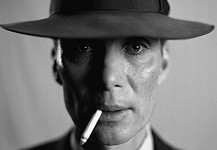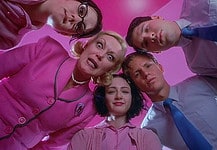Last Updated on November 2, 2021, 4:47 PM | Published: November 2, 2021
Nostalgia is a drug and it’s never been more popular or more easily accessible than right now.
Like any drug, the first blissful hits are wonderful, but then the effects get weaker, the shine wears off, and the enjoyment eventually fades away completely, leaving only the desperation and pain that was always there beneath the surface right from the beginning.
In the simplest possible terms, that’s a pretty well-encompassing synopsis of writer/director Edgar Wright’s new offering “Last Night in Soho,” give or take some time travel, ghosts, and psychological Euro-horror.
The central conceit of the film is the undying, youthful obsession with the 1960s, and the insistence on idealizing that period based on the legendary fashion, music, cars, and celebrities.
America is currently seeing a major (and arguably inexplicable) resurgence of 80’s and 90’s pop culture, and the entire world is lately in the throes of a complicated mishmash of seemingly all pop culture periods at once, but British youth, and in many ways particularly young British women, have been head-over-heels for the ’60s for years now.
Wright himself is possibly even a major factor in that, actually. With his first two cinematic breakout successes, “Shaun of the Dead” and “Hot Fuzz,” he was one of the first modern filmmakers to take the usually stark, oppressive London city and the pastoral sparseness of English countryside towns and make them colorful, fun, and lively. At a time when most British film was still focused on soft-spoken dramas and historical adaptations, Wright came along and infused his movies with the kind of plotting brilliance and uproarious energy that was bound to convert even Quentin Tarantino into a diehard fan.
And of course, the soundtracks.
There is no one else in modern filmmaking that can pinpoint the perfect obscure, nostalgic pop song for a scene like Wright. His encyclopedic recall of pop music from each and every era of pop culture is second to none and has enabled him to meticulously craft soundtracks for his films that help tell and propel the story as much as his dialogue. And his soundtracks are never without at least a couple of pitch-perfect 60’s gems.
And it’s with that attitude, with that same swinging, glamorous reverence for 60’s London, that Wright opens “Last Night in Soho.”
Our heroine is Eloise, an aspiring fashion designer addicted to all things 60’s on her way to live in London for school. Eloise, or Ellie, is also hiding a supernatural secret involving ghosts, whispers, and the occasional time-travelling, body-swapping dream.
She eventually moves into a perfectly period-decorated apartment and begins to have dreams where she inhabits the body of exactly the kind of strong-willed, glamorous 60’s girl that she’d love to be. She gets to experience running around the city at the height of its heyday, gets to sing and dance on historic stages and classic dance floors, and gets swept off her feet by a handsome 1960’s man in a 1960’s suit.
Back in 2021, she is nervous and anxious. A neon sign outside her bedroom window flashes blue, then white, then red over and over, never stopping, always washing the frame in neon color like an unsettling Dario Argento movie. It’s always raining.
In the ’60s, she’s Sandie, and she’s being swept around London and introduced to the society that so infatuates Ellie.
Right up until she starts to realize that there’s something sinister and scary and unsavory about the men wooing and romancing Sandie in her dreams. There’s something just barely beneath the surface of this time that Ellie has idealized, just the same as so many other young people have idealized it.
But it’s not ghosts. The ghosts are in 2021, in Ellie’s real life. The ghosts don’t normally scare her. She lives with them every day.
The evil in her dreams is just the 60’s. It’s the men and the drugs and the ease with which dreams were manipulated and crushed and distorted. The horror of the film doesn’t arise from the bleak, rainy, Argento-colored modern world, it grows out of the glitzy and wondrous nostalgia of the past until it bleeds through and infects the present day.
You see the 60’s, and it’s beautiful on the surface, but it’s easy to start to see what’s missing there and what’s present now. When Ellie is in 2021, her professor is a woman, the owner of the bar where the students hang out is a woman, her landlady is a woman. These are women with standing and with actual power. Back in the ’60s, Sandie’s strength is just another commodity to be bought and sold by the men that are using her.
In 2021, a young black man becomes Ellie’s closest friend at school. In the 60’s, you don’t see many people of color at all.
“Last Night in Soho” is a story about that desire to look back, to recreate yourself in the image that you admire, to disregard or ignore the horrors of history, and to recast yourself as the best parts of the past within the context of the present.
And that’s exactly how Wright is able to develop what might be his most impressively sub-textual soundtrack ever.
Many of the songs, especially the ones featured most prominently, are songs from the 1960s that found greater success, and deeper pop-culture consciousness, in the form of cover versions later. “I’ve Got My Mind Set on You” and “Always Something There to Remind Me,” are lyrically perfect for their scenes and placements, but also serve as reminders that before they were repurposed as smash hits in the 80’s, they were nearly forgotten minor hits in the 60’s.

Nearly forgotten just like so many women and so many women’s dreams from that so idealized and bygone time. Just like Sandie herself.
Ellie wants to save Sandie, but she can’t change the past. She can only watch it, and she can only stand by in horror as the ghostly relics that she’s stirring up from that period begin haunting her in her waking life.
Watching this film, it struck me how rare it is to see a movie about a woman just trying to help another woman. They’re not sisters, and it’s not a mother/daughter thing, it’s just one young woman recognizing the danger that another young woman is in and fighting desperately to help. That aspect alone feels surprisingly unique, even if some of the twists and turns in the plot feel a little predictable or rehashed.
Eventually, revelations have to be made, mysteries have to be explained, and the two parallel timelines have to come together, and they do so neatly and appropriately and, yes, a bit predictably, especially if you know how Wright likes to design and write his plots and dialogue. The film’s grand finale feels at least somewhat overdone, but that’s mostly because Wright and co-writer Krysty Wilson-Cairns have to wrap up and resolve a story filled with issues that have never fully been resolved in our world.
The final, climactic exchange between the main characters is heartbreaking and blunt. It makes no excuses and, like the rest of the film, doesn’t attempt to soften the horrors and revelations that came before.
“Last Night in Soho” may not be Wright’s best or most perfect film (that distinction is a toss-up for me between “The World’s End” and “Scott Pilgrim vs. the World”) but it’s undeniably a step forward in his maturity as a filmmaker and storyteller, and it may even be a keen look back at himself and the nostalgia that has kept him so high for so long.
“Last Night in Soho” is now playing at Rodeo Cinema in Stockyards City as well as Harkins Theaters in Bricktown and Cinemark Tinseltown.
Brett Fieldcamp has been covering arts, entertainment, news, housing, and culture in Oklahoma for nearly 15 years, writing for several local and state publications. He’s also a musician and songwriter and holds a certification as Specialist of Spirits from The Society of Wine Educators.











